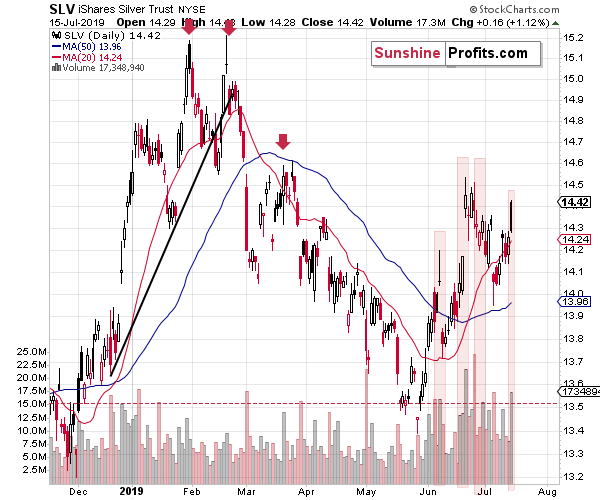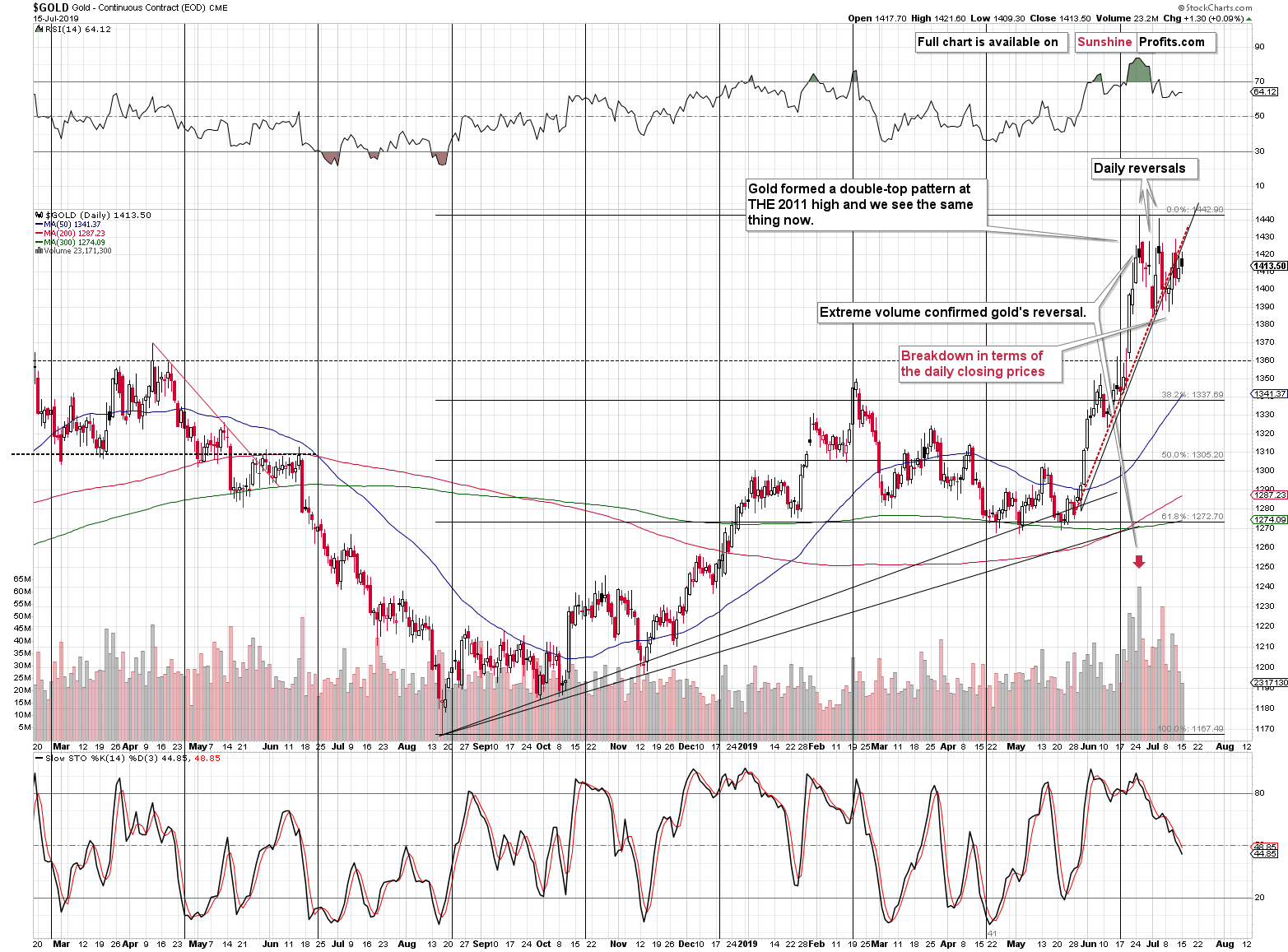Briefly: in our opinion, full (250% of the regular size of the position) speculative short position in gold, silver, and mining stocks are justified from the risk/reward perspective at the moment of publishing this Alert.
There's not much to say about yesterday's session while looking at gold - while the yellow metal closed the day only about $1 higher, things get much more interesting when we look at what happened in the silver space. The white metal moved higher decisively, almost rallying through the previously broken support line. And silver's most popular ETF - SLV - rallied on huge volume, which appears to be confirming its strength. However, the truth is that there is much more to this story than what's visible on the surface. What lurks beneath can bite and rip reckless investors apart with its sharp silver teeth.
The danger here comes from the rule that we emphasized many times in the past and that we will show you applied to this year in practice. Silver outperforms gold right before plunging. Period. And if we see huge volume in silver and/or SLV, then the signal is even stronger as it simply underlines how significant the outperformance was.
Why does it work? There's no 100% certainty regarding any why's on the market, but our view is that it's because of much greater participation of individual investors in the silver market than is the case with big institutions and governments. In most cases, individual investors are more emotional than institutions, which means that they will tend to buy at the tops. More investors that are buying at the top in silver than in case of gold, should result in silver's outperformance close to tops. And does it really happen? Let's take a look at this year's performance of the SLV ETF.
Similar Cases of Silver Strength
We marked the cases when SLV moved higher on huge volume (bigger than 15M) - there were only three and they were all local tops. This includes the June high. These were also the times when silver outperformed gold at least on a very short-term (intraday) basis. There are also other notable cases when SLV's volume was big on a relative basis and silver showed strength: late January, late February, and mid-March. These were all short-term tops.
Silver's rally really is a bearish factor if it's not accompanied by rallies in gold and mining stocks. And that's exactly what we saw yesterday, and that's the key development to emphasize today. The second (and final, as barely anything else happened) thing is the shape of yesterday's candlestick in gold.
Gold's Peculiar Rising Candle
The yellow metal moved lower during the US session, but it opened visibly above the previous day's close and thus it ended the day above the previous closing price, even though it declined during the US session. These cases are marked with black on the above chart, and they are quite often seen at the tops.
Please note that this was the case in the last two local tops - the one that we saw in late June and the one from early July. Interestingly, these were the two highest closing prices of the year. This analogy suggests that lower gold prices are just around the corner.
Summary
Summing up, silver's rally has bearish implications as it wasn't accompanied by similar action in gold and mining stocks, and the shape of yesterday's candlestick in gold suggests that we just saw the third local top. Given that both developments happened below gold's and silver's respective rising resistance lines (the breakdowns below them were not invalidated), the implications are even more bearish. Moreover, the above happened in addition to and after we saw multiple long-term signs pointing to lower prices in the following months, i.a. the clear huge-volume-confirmed bearish shooting star candlestick in gold, huge volume topping signs from both: gold and silver, the triangle-vertex-based reversals, and epic volume from silver stocks. The next big move in the precious metals sector is most likely going to be down, not up.
As always, we'll keep you - our subscribers - informed.
To summarize:
Trading capital (supplementary part of the portfolio; our opinion): Full short position (250% of the full position) in gold, silver, and mining stocks is justified from the risk/reward perspective with the following stop-loss orders and exit profit-take price levels:
- Gold: profit-take exit price: $1,241; stop-loss: $1,452; initial target price for the DGLD ETN: $51.87; stop-loss for the DGLD ETN $31.67
- Silver: profit-take exit price: $13.81; stop-loss: $16.32; initial target price for the DSLV ETN: $39.38; stop-loss for the DSLV ETN $23.87
- Mining stocks (price levels for the GDX ETF): profit-take exit price: $17.61; stop-loss: $26.47; initial target price for the DUST ETF: $34.28; stop-loss for the DUST ETF $9.87
In case one wants to bet on junior mining stocks' prices (we do not suggest doing so - we think senior mining stocks are more predictable in the case of short-term trades - if one wants to do it anyway, we provide the details), here are the stop-loss details and target prices:
- GDXJ ETF: profit-take exit price: $24.71; stop-loss: $37.17
- JDST ETF: profit-take exit price: $78.21 stop-loss: $22.47
Long-term capital (core part of the portfolio; our opinion): No positions (in other words: cash)
Insurance capital (core part of the portfolio; our opinion): Full position
Whether you already subscribed or not, we encourage you to find out how to make the most of our alerts and read our replies to the most common alert-and-gold-trading-related-questions.
Please note that the in the trading section we describe the situation for the day that the alert is posted. In other words, it we are writing about a speculative position, it means that it is up-to-date on the day it was posted. We are also featuring the initial target prices, so that you can decide whether keeping a position on a given day is something that is in tune with your approach (some moves are too small for medium-term traders and some might appear too big for day-traders).
Plus, you might want to read why our stop-loss orders are usually relatively far from the current price.
Please note that a full position doesn't mean using all of the capital for a given trade. You will find details on our thoughts on gold portfolio structuring in the Key Insights section on our website.
As a reminder - "initial target price" means exactly that - an "initial" one, it's not a price level at which we suggest closing positions. If this becomes the case (like it did in the previous trade) we will refer to these levels as levels of exit orders (exactly as we've done previously). Stop-loss levels, however, are naturally not "initial", but something that, in our opinion, might be entered as an order.
Since it is impossible to synchronize target prices and stop-loss levels for all the ETFs and ETNs with the main markets that we provide these levels for (gold, silver and mining stocks - the GDX ETF), the stop-loss levels and target prices for other ETNs and ETF (among other: UGLD, DGLD, USLV, DSLV, NUGT, DUST, JNUG, JDST) are provided as supplementary, and not as "final". This means that if a stop-loss or a target level is reached for any of the "additional instruments" (DGLD for instance), but not for the "main instrument" (gold in this case), we will view positions in both gold and DGLD as still open and the stop-loss for DGLD would have to be moved lower. On the other hand, if gold moves to a stop-loss level but DGLD doesn't, then we will view both positions (in gold and DGLD) as closed. In other words, since it's not possible to be 100% certain that each related instrument moves to a given level when the underlying instrument does, we can't provide levels that would be binding. The levels that we do provide are our best estimate of the levels that will correspond to the levels in the underlying assets, but it will be the underlying assets that one will need to focus on regarding the signs pointing to closing a given position or keeping it open. We might adjust the levels in the "additional instruments" without adjusting the levels in the "main instruments", which will simply mean that we have improved our estimation of these levels, not that we changed our outlook on the markets. We are already working on a tool that would update these levels on a daily basis for the most popular ETFs, ETNs and individual mining stocks.
Our preferred ways to invest in and to trade gold along with the reasoning can be found in the how to buy gold section. Additionally, our preferred ETFs and ETNs can be found in our Gold & Silver ETF Ranking.
As a reminder, Gold & Silver Trading Alerts are posted before or on each trading day (we usually post them before the opening bell, but we don't promise doing that each day). If there's anything urgent, we will send you an additional small alert before posting the main one.
=====
Latest Free Trading Alerts:
The combination doesn't feel right. Actually, something stinks - just what is it exactly? Payrolls were strong, while core inflation rose. Nevertheless, the Fed signaled it's going to cut interest rate. Our shiny yellow friend, can you help us make sense of it all?
Core Inflation Rises but Fed Is Going to Cut Rates. Will Gold Gain?
=====
Thank you.
Sincerely,
Przemyslaw Radomski, CFA
Editor-in-chief, Gold & Silver Fund Manager





